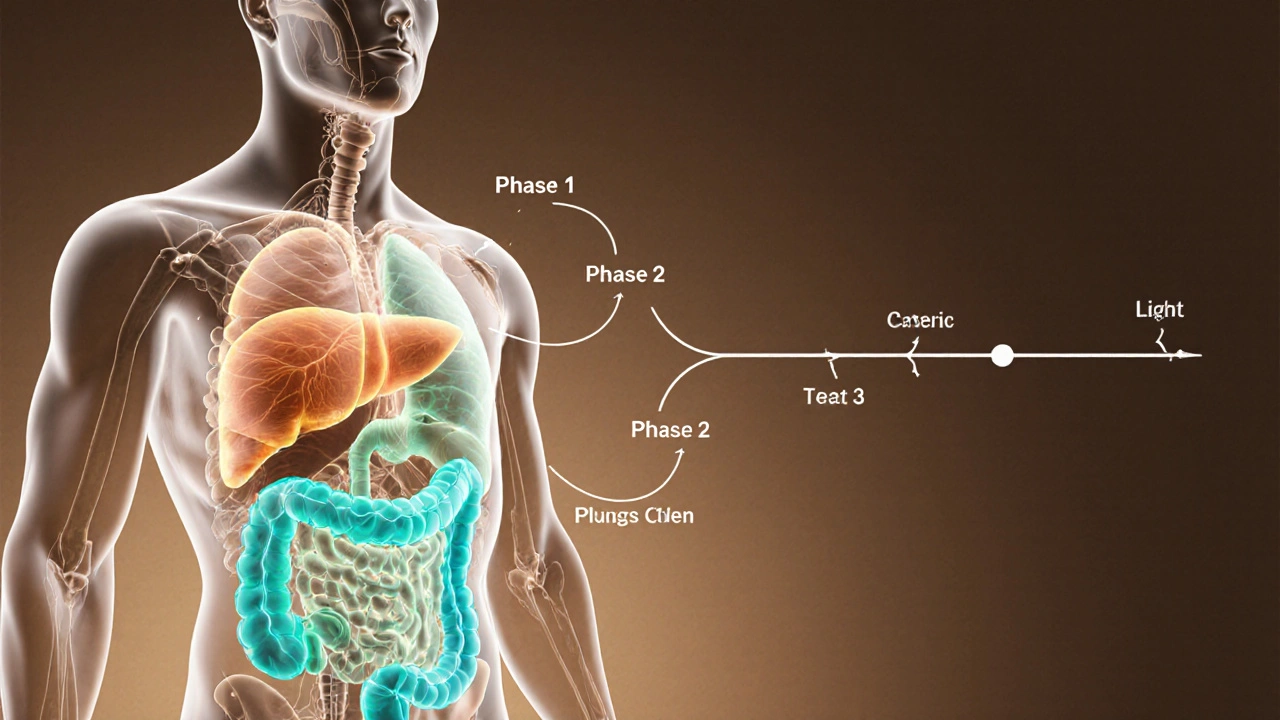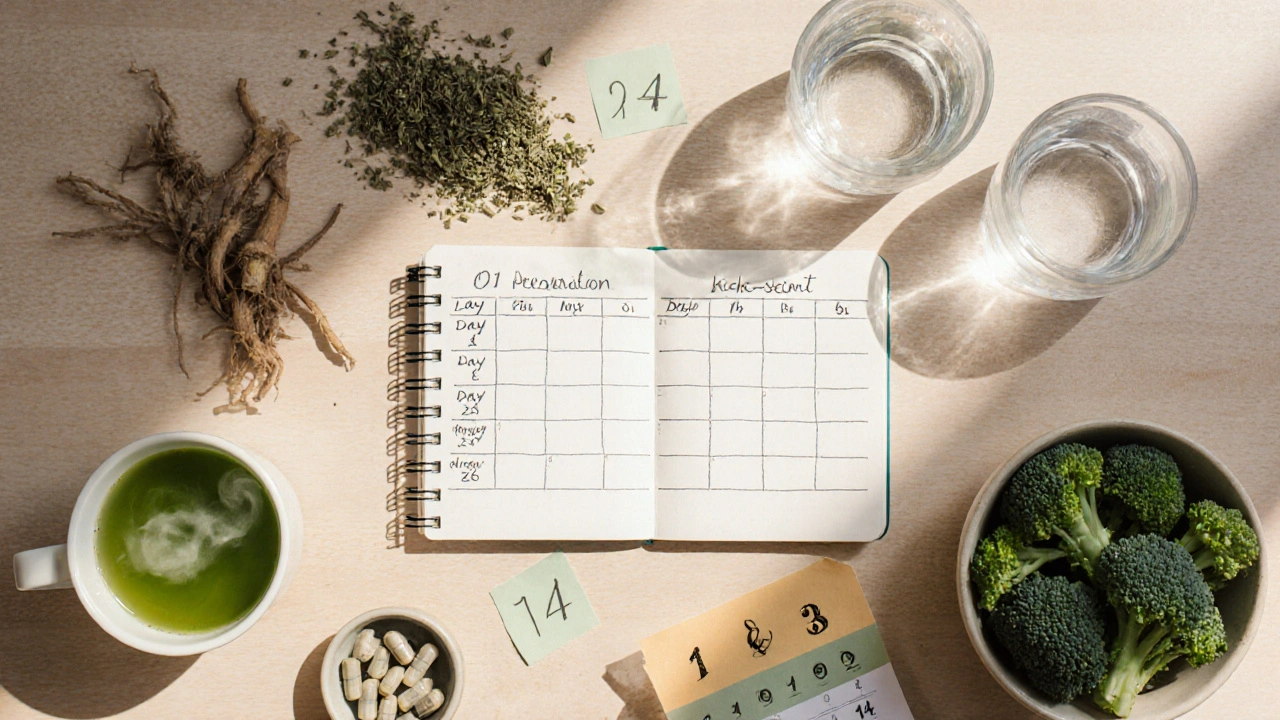
Personalized Detox Timeline Calculator
How Long Will Your Detox Take?
Based on your personal factors, this calculator estimates your detox timeline using the science from our article.
Your Estimated Detox Timeline
Your personalized detox timeline will appear here
When you hear the phrase body detox timeline, you probably picture a magic cleanse that wipes out toxins in a weekend. In reality, detox is a steady process that hinges on how well your organs work and what you feed them. Below, we break down the science, the usual time frames, and how herbal helpers fit into the picture.
What Your Body Does Naturally
Every day, Detoxification is the body’s built‑in process of filtering, transforming, and eliminating waste substances runs in the background. It isn’t a trendy fad; it’s a set of biochemical pathways that keep you healthy.
Phase1 in the liver adds chemical tags to toxins, making them easier to handle. Phase2 attaches water‑soluble groups, allowing the kidneys and intestines to flush them out. When any step stalls, you might feel sluggish, get skin eruptions, or notice digestive hiccups.
Key Organs That Lead the Detox
The liver is the star, but it works hand‑in‑hand with the kidneys, colon, lungs, and skin. Here’s a quick snapshot:
- Liver processes chemicals, breaks down fats, and produces bile for waste removal
- Kidneys filter blood, balance electrolytes, and excrete water‑soluble toxins as urine
- Colon eliminates solid waste and harbors microbes that help break down fibers
- Lungs expel volatile compounds like alcohol and certain organic solvents.
- Skin sweats out trace metals and excess heat through sweat glands.
What Influences Detox Speed
Several personal factors tweak the timing:
- Age - metabolism slows after 40, stretching each phase.
- Genetics - some people carry more efficient versions of liver enzymes.
- Hydration - water is the carrier that moves soluble toxins to the kidneys.
- Nutrition - a diet rich in antioxidants supports Phase2 conjugation.
- Stress levels - cortisol can divert liver resources toward glucose production instead of detox.
Without addressing these variables, any detox plan will produce mixed results.

Common Detox Methods and Their Typical Durations
| Method | Typical Duration | Main Active Component | Key Benefits | Common Risks |
|---|---|---|---|---|
| Herbal detox (e.g., milk thistle, dandelion root) | 7‑14days | Milk thistle contains silymarin, a liver‑protective flavonoid | Improved liver enzymes, reduced bloating | Mild GI upset if taken on an empty stomach |
| Water fasting | 24‑72hours (short‑term) | Autophagy activation | Rapid weight loss, cellular cleanup | Electrolyte imbalance, dizziness |
| Juice cleanse | 3‑5days | High‑dose vitamins, phytonutrients | Increased antioxidant load | Blood sugar swings, muscle loss |
| Colon hydrotherapy | 1‑2sessions (30min each) | Mechanical flushing | Immediate stool output, feeling lighter | Bacterial imbalance if overused |
| Balanced whole‑food diet | Ongoing (minimum 30days for measurable change) | Fiber, polyphenols, omega‑3s | Steady enzyme support, gut microbiome diversity | None when nutritionally adequate |
A Realistic Timeline for a Full Detox
Think of detox as a marathon, not a sprint. Below is a day‑by‑day guide that aligns with the body’s natural rhythm.
- Day0‑1 (Preparation): Hydrate, cut processed sugar, start light herbal teas such as Green tea rich in catechins that boost Phase2 enzymes. This primes Phase1 reactions.
- Day2‑3 (Kick‑start): Introduce Dandelion root acts as a diuretic, helping kidneys flush water‑soluble toxins and milk thistle capsules. Expect increased urination and possibly mild belly rumble.
- Day4‑7 (Deepening): Body shifts to Phase2 conjugation. Glutathione levels rise, especially if you’re eating cruciferous veggies like broccoli. You may notice clearer skin and steadier energy.
- Day8‑14 (Stabilization): Herbs continue supporting liver regeneration. Gut microbiome feeds on fiber, producing short‑chain fatty acids that aid toxin excretion. By day10 most people feel lighter, with regular bowel movements.
- Beyond Day14 (Maintenance): Detox isn’t a one‑off event. Keep drinking herbal teas, stay hydrated, and maintain a diet rich in antioxidants to keep the pathways running smoothly.
Overall, a thorough, herb‑supported detox usually spans **seven to fourteen days**, though the exact length depends on the factors listed earlier.
How to Support Your Body During Detox
Here are practical moves you can add to any plan:
- Drink at least 2‑3liters of filtered water daily.
- Include a handful of fresh herbs (parsley, cilantro) in salads for additional chelation.
- Sleep 7‑9hours; the liver does most of its heavy lifting at night.
- Practice gentle movement-yoga or brisk walks keep circulation strong.
- Limit alcohol and caffeine, which tax the liver’s Phase1 enzymes.

Safety Tips and When to Seek Professional Help
Detox isn’t a free pass to ignore red flags. If you experience any of the following, pause and talk to a clinician:
- Persistent dizziness or heart palpitations.
- Severe GI distress lasting more than 48hours.
- Sudden changes in urine color (e.g., deep orange) without a clear dietary cause.
- Pre‑existing liver or kidney disease - self‑directed detox can overwhelm compromised organs.
Blood tests for ALT, AST, and creatinine before and after a detox can verify that you’re not causing harm.
Bottom Line
Detox isn’t a quick magic trick; it’s a coordinated effort of liver, kidneys, colon, and the rest of your system. A realistic, herb‑backed schedule runs about one to two weeks, with the first week handling the heavy lifting and the second week cementing the gains.
Stick to hydration, balanced nutrition, and safe herbal allies, and you’ll give your body the time it truly needs to clean house.
Frequently Asked Questions
Can I speed up detox with more herbs?
Adding extra herbs occasionally helps, but too many can overload the liver. Stick to the recommended dosages and let the body’s enzymes work at their natural pace.
Is a juice cleanse faster than an herbal detox?
Juice cleanses may feel faster because they reduce solid food, but they lack the liver‑protective compounds found in milk‑thistle or dandelion. Healthier is a balanced herb plan plus whole foods.
How often should I do a full detox?
Once or twice a year is enough for most adults. Frequent detoxes can thin essential nutrients and stress the liver.
Do I need to fast during an herbal detox?
No. In fact, eating light, plant‑based meals fuels Phase2 detox pathways while keeping energy stable.
What lab tests show if detox worked?
Check liver enzymes (ALT, AST), kidney function (creatinine, BUN), and a basic metabolic panel. Lowered toxin markers and stable values indicate success.


10 Comments
Wow, reading this felt like watching a drama about the body’s hidden battles! The author finally admits that a weekend cleanse is a myth, and that is a relief. Our liver, kidneys and colon are not simple machines that can be rebooted in 24 hours. They need steady support, like a marathon runner needs proper training. The timeline laid out here makes sense: from preparation to deepening, each phase has a purpose. Phase 1 is the entry gate, adding tags to toxins, and Phase 2 cleans them out with water. If you skip the preparation stage, the organs get shocked and the whole plan can backfire. Hydration is highlighted, and it truly is the carrier that shuttles toxins to the kidneys. The mention of milk‑thistle and dandelion is spot on because silymarin really does protect liver cells. Also, the advice to sleep 7‑9 hours is crucial – the liver does most of its work at night. The guide warns against over‑fasting, which is wise; electrolyte loss can be dangerous. I also appreciate the reminder to check ALT and AST levels before and after a detox – data beats guesswork. The table of methods shows that a balanced whole‑food diet is the only approach without real risk. In short, a realistic detox is a 7‑14 day journey, not a magic weekend. This article finally respects the science and gives a clear path for anyone who wants to try it. Kudos for ditching the quick‑fix hype and giving a solid, step‑by‑step plan.
Sounds like a solid plan.
From a cultural standpoint, many traditions have always honored the body as a temple that needs regular cleansing. The modern detox craze tries to package that wisdom into a quick schedule, but the ancient practices taught patience and balance. Your timeline reminds us that true purification is a steady, mindful process, not a sprint.
The article completely ignores the role of the gut microbiome in detoxification.
I hear you, the gut is indeed a key player and its health can make or break a detox.
Our ancestors survived without any herbal pills – they ate real food and let nature do the work.
Behold! The epic saga of body detox unfolds, a drama of liver, kidneys, and heroic herbs battling the invading toxins.
Esteemed author, your exposition is commendably thorough and adheres to a high standard of scholarly rigor.
What they don’t tell you is that big pharma engineers these detox fads to push expensive supplements.
If you’re starting a detox, begin with simple steps: drink plenty of water, add a cup of green tea each morning, and include cruciferous veggies like broccoli in meals. These foods boost glutathione, the master antioxidant that aids Phase 2. Keep a consistent sleep schedule; the liver’s repair work peaks at night. Finally, track your progress with an easy journal – note energy levels, skin clarity, and bowel regularity. Small, measurable changes are far more reliable than vague promises of “instant cleansing”.